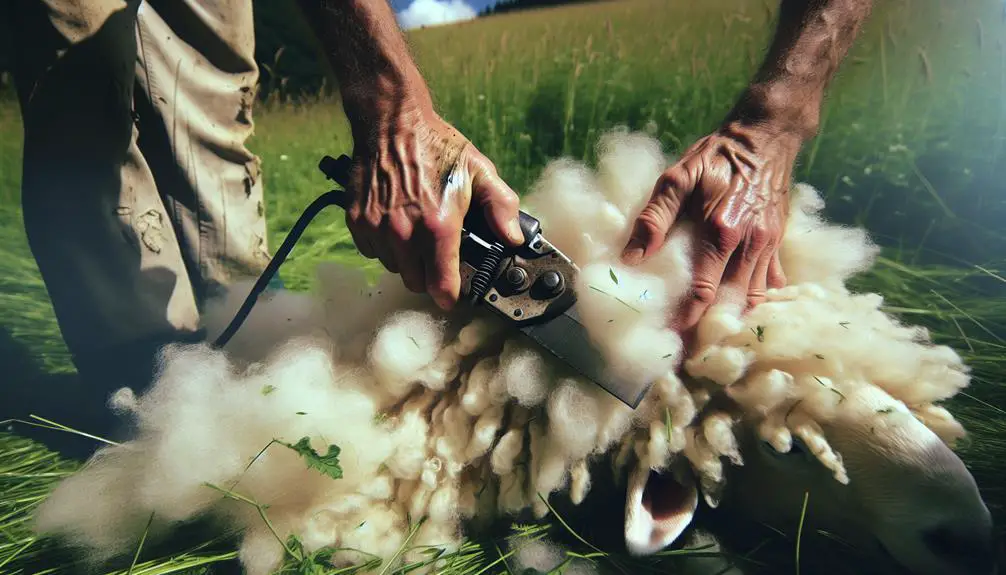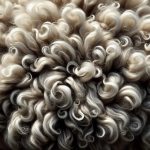Wool is made from the fine fibers of animals like sheep and goats. These fibers provide insulation, breathability, and moisture absorption. Different animal sources give wool unique qualities. Wool is resistant to wrinkles, stains, and odors, making it a versatile choice. Sheep grow a new fleece yearly, making wool a sustainable resource. The fibers are flexible and durable, bending without breaking easily. Merino wool is soft, cashmere luxurious, mohair high-crimp, and alpaca hypoallergenic. Understanding how wool is made from animals adds to its diverse appeal.
Table of Contents
Key Takeaways
- Wool fibers mainly come from animals like sheep and goats.
- Different animal sources provide unique qualities to wool.
- Wool fibers are composed of keratin, offering natural properties like insulation and breathability.
- Wool garments are resistant to wrinkling, sagging, stains, and odors.
- Wool is a sustainable source, with sheep producing a new fleece annually.
Sheep Fleece
Shearing sheep yields various types of wool fibers, each with unique qualities and properties. Sheep fleece is the primary source of wool, and it comes in different textures and thicknesses depending on the breed of sheep. This variation is a result of selective sheep breeding practices over generations.
For instance, Merino sheep produce fine and soft wool, highly sought after for its quality. The wool fibers found in sheep fleece are composed of the protein keratin, which gives wool its elasticity, durability, and ability to retain heat. Through careful sheep breeding, farmers can develop flocks that produce wool with specific characteristics, catering to different market demands.
Harvesting wool through shearing isn't only essential for obtaining this versatile material but also critical for the well-being and comfort of the sheep. This process makes sure that the sheep remain healthy and free from issues that can arise from excessive wool growth.
Natural Fiber Source
I'll start by emphasizing the natural sources of wool fibers, which mainly come from animals like sheep and goats. These animal hair fibers are rich in keratin, which gives wool its distinctive properties.
Understanding the origin of these fibers is essential in appreciating the qualities of wool products.
Animal Hair Fibers
Wool, a versatile material cherished for its warmth and durability, mainly originates from animal hair fibers, particularly sourced from sheep, goats for cashmere and mohair, and alpacas. These fibers are rich in animal protein called keratin, which provides wool with its unique properties.
Sheep wool, for instance, is known for its softness and insulation capabilities. Cashmere, derived from goats, is prized for its luxurious feel, while mohair offers a distinct sheen and durability. Alpaca wool is celebrated for being hypoallergenic and lightweight.
Each type of wool fiber has its own characteristics based on the animal source, making wool a diverse and valuable material in the textile industry.
Sheep and Goats
From the lush pastures to the skilled hands of farmers, sheep and goats play an essential role as natural fiber sources for the production of wool.
- Sheep, especially Merino sheep, are prized for their fine and high-quality wool.
- Goat wool, like cashmere and mohair, is renowned for its luxurious softness.
- Both sheep and goat wool are made of keratin, a protein that gives wool its unique properties.
- Sustainable harvesting of wool from sheep and goats is vital for the wool industry, supporting the creation of a wide array of products.
Wool Production Process
Shearing wool-bearing animals marks the initial step in the wool production process. Once the sheep are sheared, the wool is cleaned, sorted, and processed to remove impurities.
The wool fibers are then carded to align them into long strands, which are spun into yarn suitable for various applications. Additional processes like fulling, which involves shrinking and thickening the fabric, and crabbing, which removes residual oils, may be utilized to enhance the wool's properties.
Moreover, some wool products undergo dyeing processes to introduce a range of color variations, making them more visually appealing. These dyeing processes can be done at different stages of production, depending on the desired outcome.
Animal Origin of Wool
Sheep are the primary source of wool, providing us with this versatile and natural fiber.
Different types of wool come from various wool-bearing animals, each offering unique characteristics and qualities.
Understanding the animal origins of wool helps us appreciate the diversity and richness of this sustainable material.
Sheep as Wool Source
Gathering wool from these animals provides a sustainable and versatile material that's highly valued in various industries. Sheep produce wool, with Merino sheep being renowned for their high-quality Merino wool. Here are some key points about sheep as a source of wool:
- Merino wool is finer than human hair, making it soft and luxurious.
- Australian wool is a significant contributor to global wool production.
- Wool is composed of keratin, a protein also found in human hair and nails.
- Sheep's wool is prized for its versatility and natural properties, suitable for a wide range of products.
Wool-Bearing Animal Types
What animals besides sheep produce wool, and how does each type of wool differ in texture and properties?
Merino sheep provide fine wool known for its softness and elasticity, while Angora rabbits produce Angora wool, famous for its silky texture. Cashmere wool, sourced from the Kashmir region, offers exceptional warmth and softness, coming from the undercoat of Cashmere goats. Alpaca wool, originating from South America, is prized for its luxurious feel and excellent insulation.
Each type of wool has unique characteristics: Merino is soft and elastic, Angora is silky, Cashmere is warm and soft, and Alpaca is both soft and water-resistant. These diverse wool sources cater to various preferences and needs, offering a wide range of options for quality garments.
Types of Wool Fibers
Sourced from various animals around the world, wool fibers come in a diverse range of types, each with unique characteristics and properties.
- Merino wool: Hailing from Merino sheep, this wool is celebrated for its softness and fineness, making it a popular choice for high-quality garments.
- Cashmere wool: Originating from the Kashmir region, Cashmere wool is revered for its luxurious feel and lightweight nature, often used in premium clothing items.
- Mohair wool: Coming from Angora goats, Mohair wool stands out for its high-crimp woolen textiles that possess a lovely luster and resilience.
- Alpaca wool: Bred in South America, Alpaca wool boasts fibers as small as 15 microns, making it hypoallergenic, water-resistant, and exceptionally durable.
Each type of wool fiber brings its own set of advantages, catering to different preferences and needs in the world of textiles.
Fiber Characteristics
Wool fibers possess natural properties like insulation and breathability, which help regulate body temperature in various climates. This makes wool a versatile material suitable for both warm and cool environments.
Additionally, wool is a sustainable source, as sheep produce a new fleece annually without harming the animals.
Natural Fiber Properties
When considering natural fiber properties, one remarkable characteristic of wool is its wavy fiber structure, providing elasticity and resilience.
- Wool is primarily composed of the protein keratin, similar to human hair and nails.
- The wavy structure of wool fibers, with up to 30 waves per inch, gives them flexibility and durability.
- Wool fibers have a diameter ranging from about 16 to 40 microns, with finer fibers feeling softer and more luxurious.
- Wool can absorb moisture up to 16-18% of its weight, making wool fabrics breathable and comfortable to wear.
Understanding these natural fiber properties sheds light on why wool is a popular choice for various textile applications.
Insulation and Breathability
Considering wool's natural crimps that effectively trap air and its moisture-wicking properties, let's explore how these fiber characteristics contribute to insulation and breathability. Wool fibers, with their inherent crimp, create tiny air pockets that lock in heat, providing exceptional insulation for cold weather. Simultaneously, this crimp structure allows for breathability by drawing moisture away from the body, keeping you dry and comfortable.
Wool's ability to absorb and release moisture helps regulate body temperature, making it an ideal choice for various climates. This insulation property makes wool a popular option for outdoor and athletic wear, ensuring warmth without overheating. Additionally, wool's capacity to provide warmth even when wet adds to its versatility in different weather conditions.
Sustainable Material Source
With its unique fiber characteristics, wool serves as a sustainable material source that offers insulation, breathability, and moisture management benefits for various applications. Wool's natural properties make it an environmentally friendly choice for textiles.
Here are some key points highlighting why wool is a sustainable material source:
- Wool is biodegradable, reducing environmental impact.
- The fiber's insulation properties help save energy by reducing heating and cooling needs.
- Wool's breathability allows for comfortable wear in various climates.
- Its moisture management capabilities wick away sweat, keeping skin dry and comfortable.
Wool Fiber Properties
Wool fibers, consisting of the protein keratin, are remarkably fine and resilient compared to human hair. These fibers typically range from 16 to 40 microns in diameter, making them much thinner than human hair. Additionally, wool fibers have a unique wavy structure with up to 30 waves per inch, contributing to their elasticity and resilience. This wavy pattern allows the fibers to bend and stretch without breaking easily, making wool a durable material.
The elasticity of wool is a result of its wavy structure, allowing it to return to its original shape after being stretched or compressed. This property makes wool garments resistant to wrinkling and sagging, maintaining their appearance over time. The keratin in wool also provides natural protection against stains and odors, making it a practical choice for various applications from clothing to home textiles. Wool's ability to resist breakage and stretching to a certain extent makes it a versatile and long-lasting material with a wide range of uses.
Animal Fleece Varieties
Coming from a variety of animals such as sheep, goats, rabbits, and even camels, wool is primarily sourced from their fleece. Different animals produce unique types of wool, each with its own distinct qualities:
- Merino wool: Known for its fine texture and excellent warmth, Merino wool comes from Merino sheep, primarily raised in Australia and New Zealand.
- Angora wool: Sourced from Angora rabbits, this wool is prized for its extreme softness and fluffiness, making it ideal for luxurious garments and accessories.
- Cashmere wool: Cashmere wool is obtained from cashmere goats and is highly regarded for its softness, lightweight feel, and insulation properties.
- Camel wool: Collected from camels, camel wool is valued for its natural shades and exceptional insulating capabilities, making it perfect for cold weather garments.
These different animal fleece varieties offer a wide range of textures, warmth, and unique characteristics, catering to various preferences and needs in the world of wool production.
Fiber Processing Methods
Utilizing two main fiber processing methods, the wool industry distinguishes between worsted and woollen systems for creating different types of yarn. The worsted system is known for producing smoother and finer wool yarns, making it a popular choice for traditional tailoring and sportswear. This method involves combing longer fibers to align them parallel before spinning, resulting in a yarn with less bulk and more durability.
In contrast, the woollen system utilizes shorter fibers that are carded to create a bulkier yarn suitable for woolen textiles like lambswool and tweeds. This process doesn't align the fibers as uniformly as worsted, giving the yarn a softer and fuzzier texture. Woollen fabrics and yarns are often favored for their warmth and insulation properties.
Understanding the distinction between these two fiber processing methods is essential for producing the desired characteristics in wool products, whether it be the sleekness of worsted yarns or the coziness of woollen textiles.
Sustainable Wool Resource
Switching gears from fiber processing methods, let's explore the domain of sustainable wool resources and their impact on environmentally friendly practices in wool production. Sustainable wool resources focus on environmentally friendly practices such as organic farming methods, reduced chemical use, and ethical treatment of animals to minimize negative impacts on the environment and promote animal welfare.
Here are some key points to ponder:
- Organic Farming Methods: Sustainable wool production often involves organic farming methods, which exclude synthetic pesticides and fertilizers, promoting soil health and biodiversity.
- Reduced Chemical Use: Emphasizing decreased chemical use in the production process helps in safeguarding water sources and ecosystems from pollution.
- Ethical Treatment of Animals: Ensuring animal welfare is an essential aspect of sustainable wool production, guaranteeing that animals are treated humanely throughout the farming and shearing processes.
- Certification Programs: Certification programs like the Responsible Wool Standard (RWS) play an important role in verifying and promoting sustainable practices within the wool industry, meeting the increasing demand for ethically produced and eco-friendly wool products.
Frequently Asked Questions
What Is 100% Wool Made Of?
Wool, a fabric known for warmth and comfort, is crafted from the protein keratin, also found in human hair and nails. Its natural crimp structure provides elasticity, and fibers ranging from 16 to 40 microns offer softness and resilience.
Why Is Wool No Longer Used?
I've noticed wool's decline in use is due to the popularity of cost-effective, easy-care synthetic fibers with specific performance benefits. Changing fashion trends and consumer preferences have also played a role.
Is Wool Only From Sheep?
Wool isn't only from sheep; it can come from goats, alpacas, and rabbits too. Each animal's wool has unique qualities for different uses. For example, Merino sheep produce soft, fine wool ideal for luxurious garments.
What Are 3 Products Made From Wool?
I can name three products made from wool: sweaters, blankets, and carpets. These items showcase the versatility and comfort of wool, making them popular choices for clothing, home decor, and furnishings due to their warmth and durability.
- Tetron Fabric for Curtains: Style and Maintenance Guide - June 18, 2025
- Tetron Fabric for Bedding: Comfort and Care Tips - June 18, 2025
- Tetron Fabric for Luggage: Durability and Design Tips - June 18, 2025






